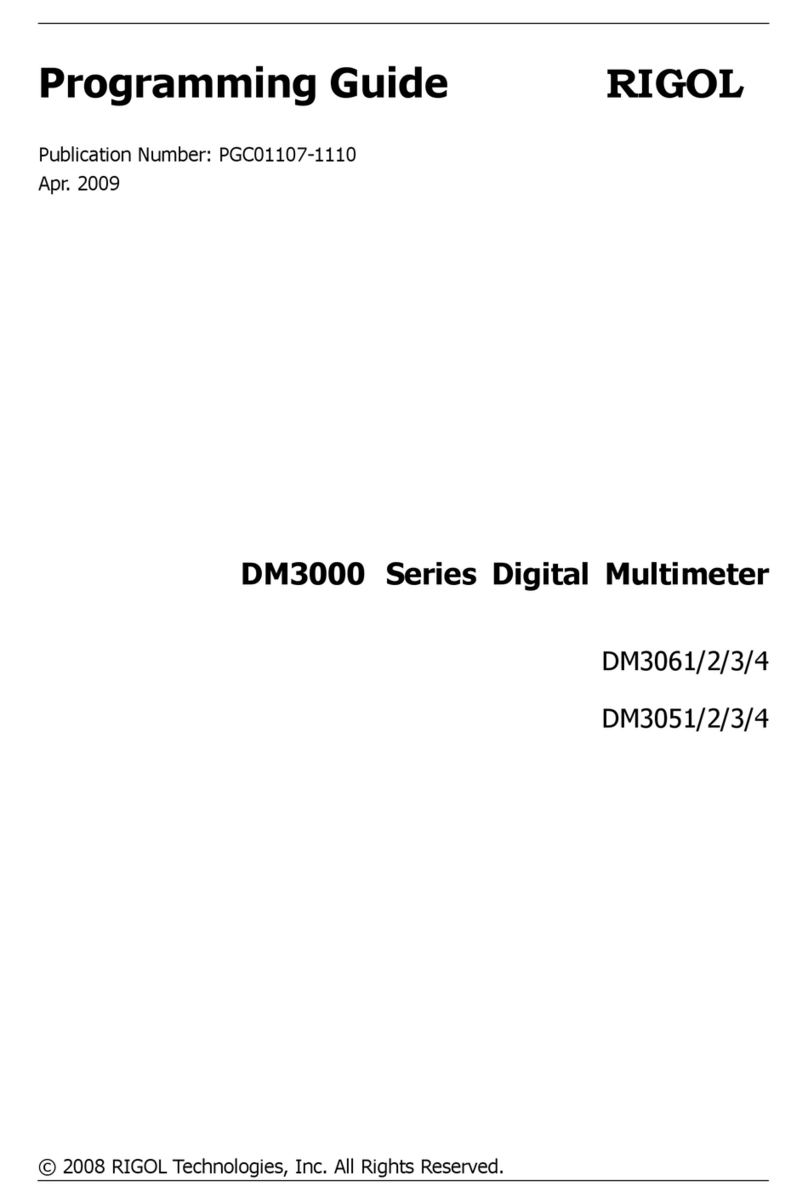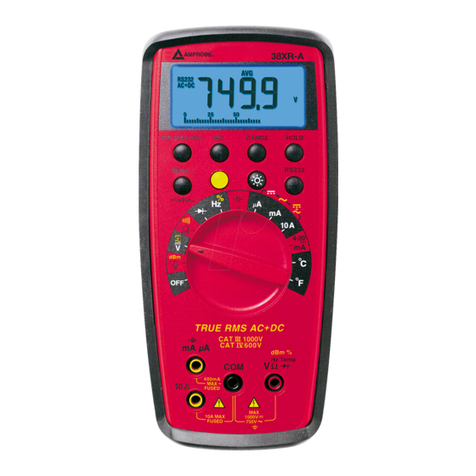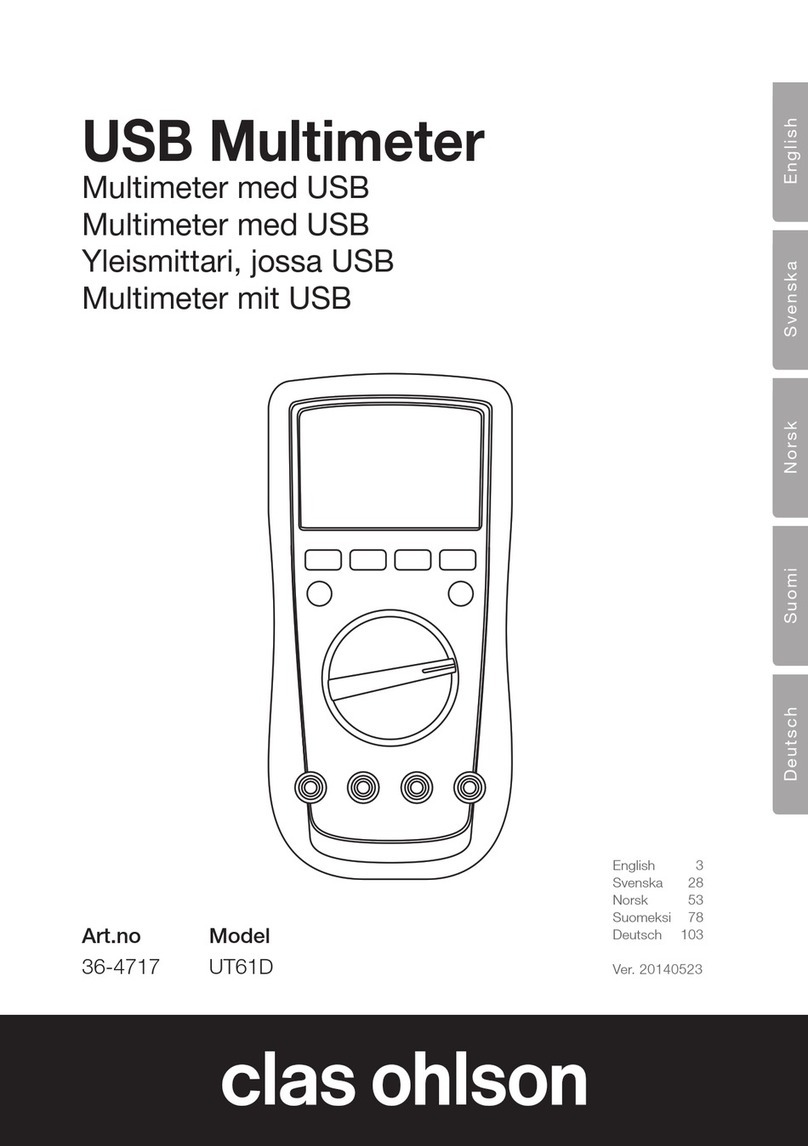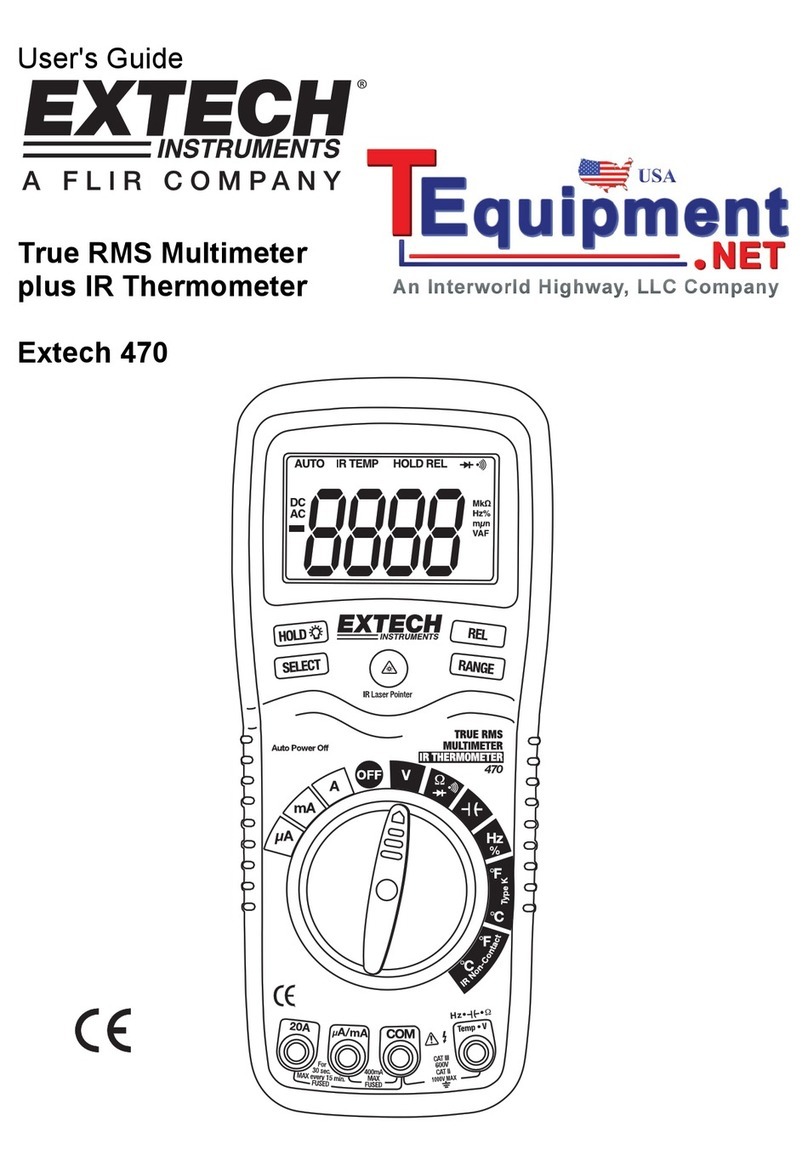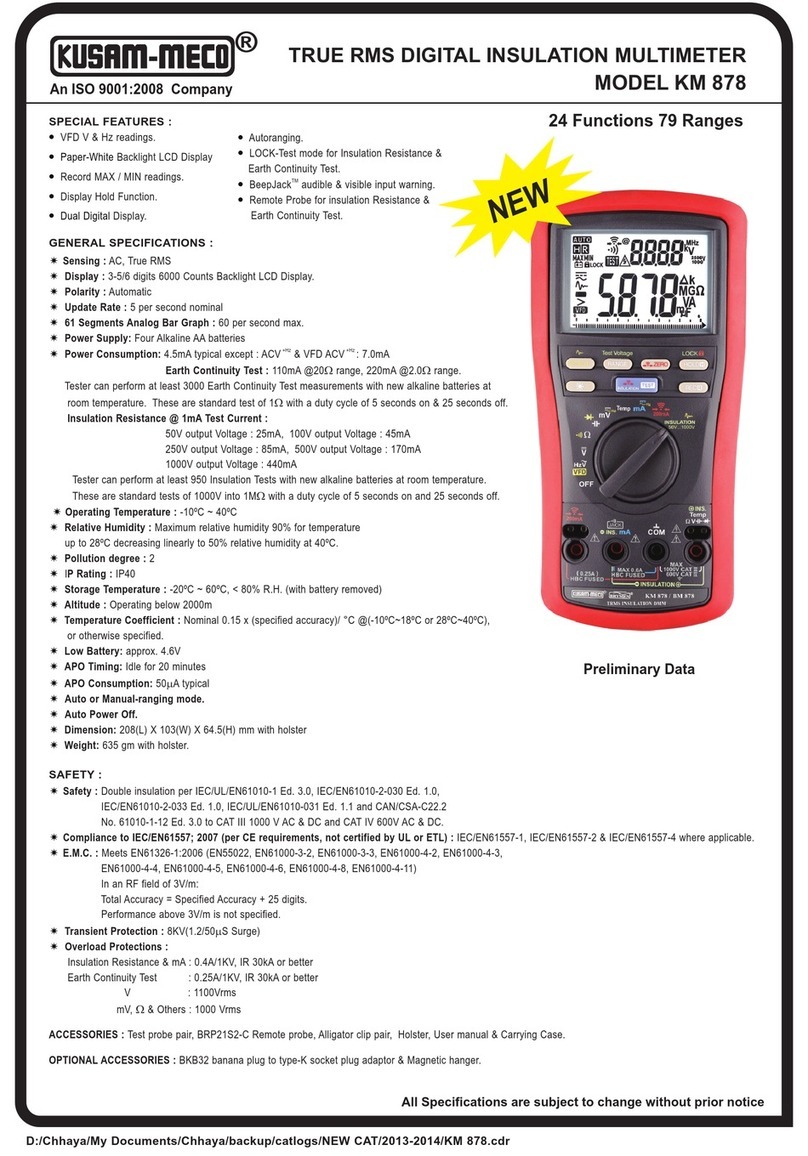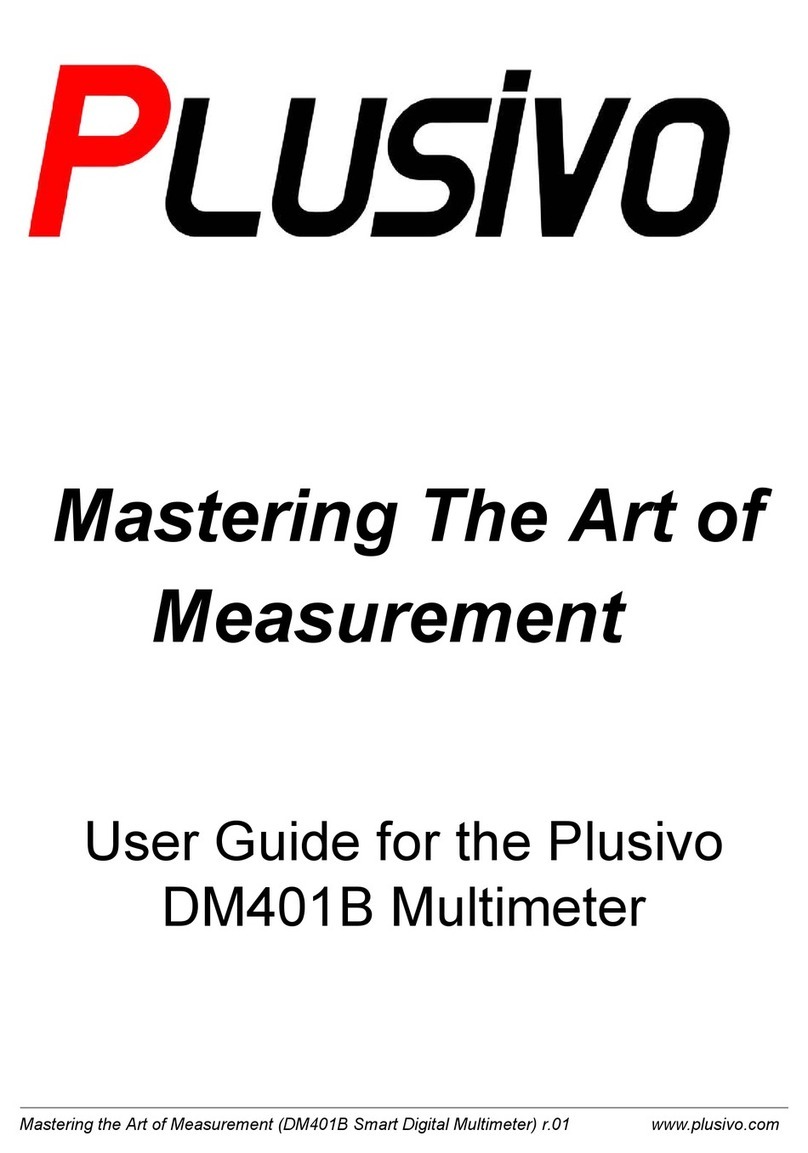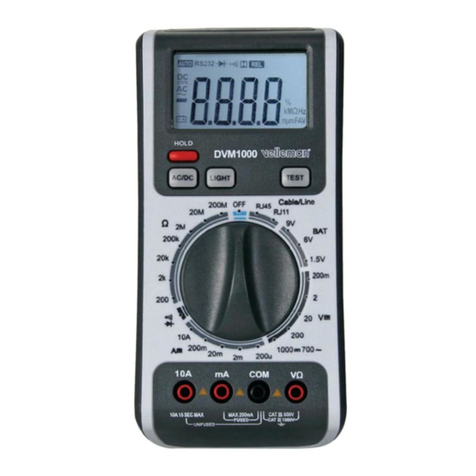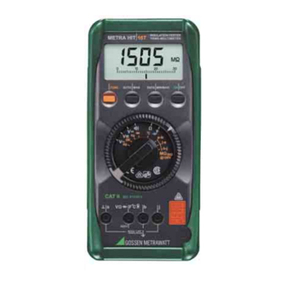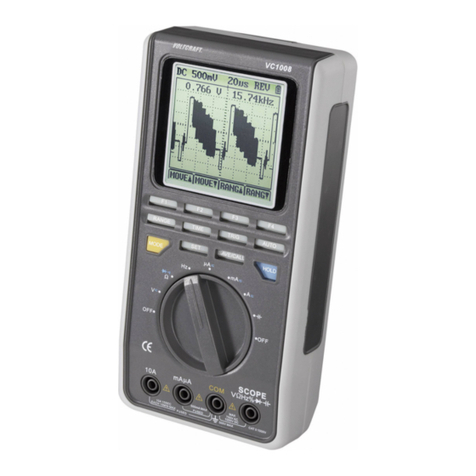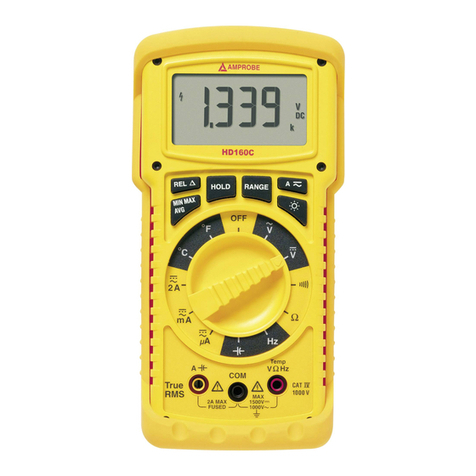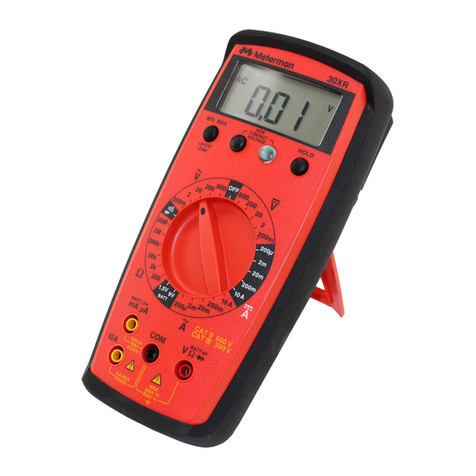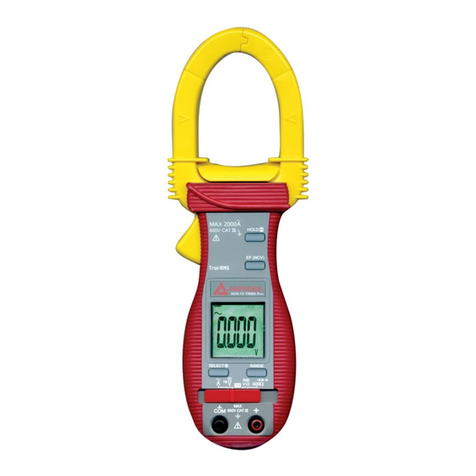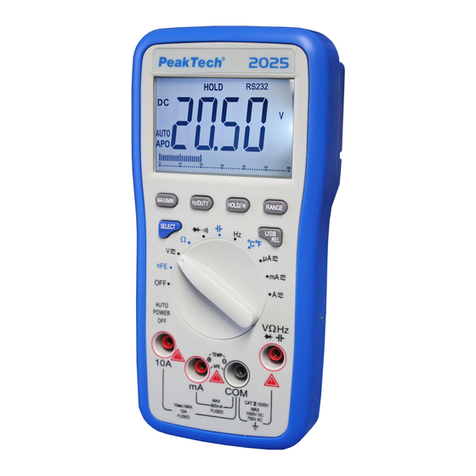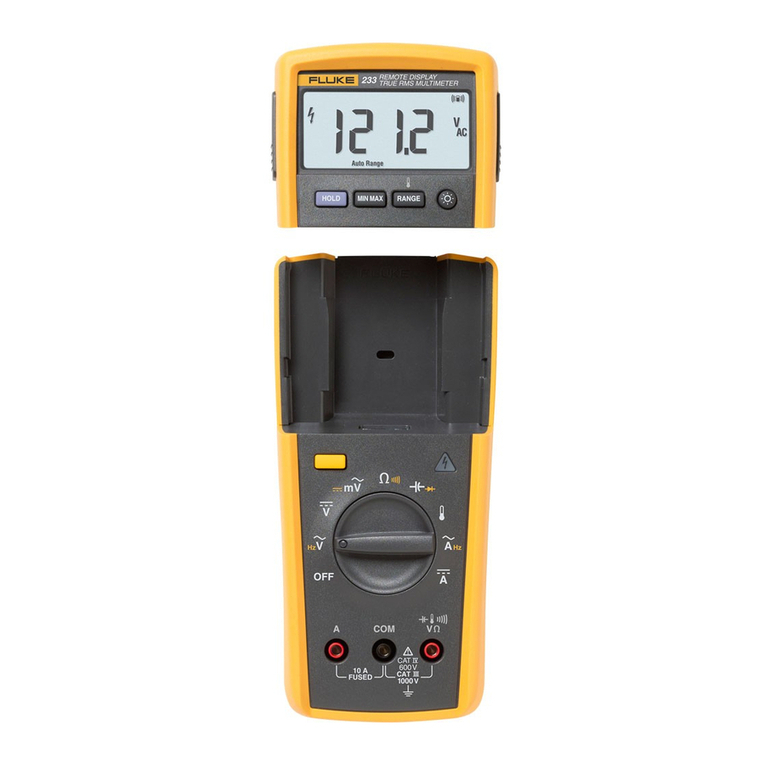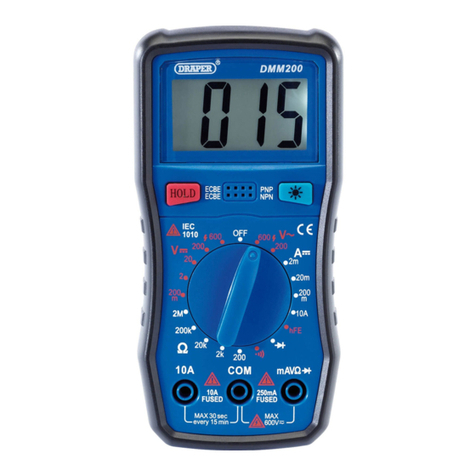Rigol DM3058 Installation and operation manual

RIGOL
Performance Verification Guide
DM3058/DM3058E
Digital Multimeter
Jan. 2015
RIGOL Technologies, Inc.


RIGOL
DM3058/DM3058E Performance Verification Guide
I
Guaranty and Declaration
Copyright
© 2014 RIGOL Technologies, Inc. All Rights Reserved.
Trademark Information
RIGOL is a registered trademark of RIGOL Technologies, Inc.
Publication Number
PVC03100-1110
Notices
RIGOL products are covered by P.R.C. and foreign patents, issued and pending.
RIGOL reserves the right to modify or change parts of or all the specifications
and pricing policies at company’s sole decision.
Information in this publication replaces all previously corresponding material.
Information in this publication is subject to change without notice.
RIGOL shall not be liable for either incidental or consequential losses in
connection with the furnishing, use or performance of this manual as well as any
information contained.
Any part of this document is forbidden to be copied, photocopied or rearranged
without prior written approval of RIGOL.
Product Certification
RIGOL guarantees this product conforms to the national and industrial standards in
China as well as the ISO9001:2008 standard and the ISO14001:2004 standard. Other
international standard conformance certification is in progress.
Contact Us
If you have any problem or requirement when using our products or this manual,
please contact RIGOL.
E-mail: service@rigol.com
Website: www.rigol.com

RIGOL
DM3058/DM3058E Performance Verification Guide
II
Safety Requirement
General Safety Summary
Please review the following safety precautions carefully before putting the instrument
into operation so as to avoid any personal injury or damage to the instrument and any
product connected to it. To prevent potential hazards, please use the instrument only
specified by this manual.
Use Proper Power Cord.
Only the power cord designed for the instrument and authorized for use within the
local country could be used.
Ground the Instrument.
The instrument is grounded through the Protective Earth lead of the power cord. To
avoid electric shock, it is essential to connect the earth terminal of the power cord to
the Protective Earth terminal before connecting any inputs or outputs.
Connect the Probe Correctly.
If a probe is used, do not connect the ground lead to high voltage since it has isobaric
electric potential as the ground.
Observe All Terminal Ratings.
To avoid fire or shock hazard, observe all ratings and markers on the instrument and
check your manual for more information about ratings before connecting the
instrument.
Use Proper Overvoltage Protection.
Make sure that no overvoltage (such as that caused by a thunderstorm) can reach the
product, or else the operator might be exposed to the danger of electrical shock.
Do Not Operate Without Covers.
Do not operate the instrument with covers or panels removed.
Do Not Insert Anything Into the Holes of Fan.
Do not insert anything into the holes of the fan to avoid damaging the instrument.
Use Proper Fuse.
Please use the specified fuses.
Avoid Circuit or Wire Exposure.
Do not touch exposed junctions and components when the unit is powered.
Do Not Operate With Suspected Failures.
If you suspect damage occurs to the instrument, have it inspected by RIGOL

RIGOL
DM3058/DM3058E Performance Verification Guide
III
authorized personnel before further operations. Any maintenance, adjustment or
replacement especially to circuits or accessories must be performed by RIGOL
authorized personnel.
Keep Well Ventilation.
Inadequate ventilation may cause an increase of instrument temperature which would
cause damage to the instrument. So please keep the instrument well ventilated and
inspect the intake and fan regularly.
Do Not Operate in Wet Conditions.
In order to avoid short circuiting to the interior of the device or electric shock, please
do not operate the instrument in a humid environment.
Do Not Operate in an Explosive Atmosphere.
In order to avoid damage to the device or personal injuries, it is important to operate
the device away from an explosive atmosphere.
Keep Product Surfaces Clean and Dry.
To avoid the influence of dust and/or moisture in the air, please keep the surface of the
device clean and dry.
Electrostatic Prevention.
Operate the instrument in an electrostatic discharge protective environment to avoid
damage induced by static discharges. Always ground both the internal and external
conductors of cables to release static before making connections.
Proper Use of Battery.
If a battery is supplied, it must not be exposed to high temperature or in contact with
fire. Keep it out of the reach of children. Improper change of battery (note: lithium
battery) may cause explosion. Use RIGOL specified battery only.
Handling Safety.
Please handle with care during transportation to avoid damage to buttons, knob
interfaces and other parts on the panels.

RIGOL
DM3058/DM3058E Performance Verification Guide
IV
Safety Terms and Symbols
Terms Used in this Manual. These terms may appear in this manual:
WARNING
Warning statements indicate conditions or practices that could result in
injury or loss of life.
CAUTION
Caution statements indicate conditions or practices that could result in
damage to this product or other property.
Terms Used on the Product. These terms may appear on the product:
DANGER
It calls attention to an operation, if not correctly performed, could
result in injury or hazard immediately.
WARNING
It calls attention to an operation, if not correctly performed, could
result in
potential injury or hazard.
CAUTION
It calls attention to an operation, if not correctly performed, could
result in damage to the product or other devices connected to the
product.
Symbols Used on the Product. These symbols may appear on the product:
Hazardous
Voltage
Safety
Warning
Protective
Earth
Terminal
Chassis
Ground
Test
Ground

RIGOL
DM3058/DM3058E Performance Verification Guide
V
Allgemeine Sicherheits Informationen
Überprüfen Sie diefolgenden Sicherheitshinweise
sorgfältigumPersonenschädenoderSchäden am Gerätundan damit verbundenen
weiteren Gerätenzu vermeiden. Zur Vermeidung vonGefahren, nutzen Sie bitte das
Gerät nur so, wiein diesem Handbuchangegeben.
Um Feuer oder Verletzungen zu vermeiden, verwenden Sie ein
ordnungsgemäßes Netzkabel.
Verwenden Sie für dieses Gerät nur das für ihr Land zugelassene und genehmigte
Netzkabel.
Erden des Gerätes.
Das Gerät ist durch den Schutzleiter im Netzkabel geerdet. Um Gefahren durch
elektrischen Schlag zu vermeiden, ist es unerlässlich, die Erdung durchzuführen. Erst
dann dürfen weitere Ein- oder Ausgänge verbunden werden.
Anschluss einesTastkopfes.
Die Erdungsklemmen der Sonden sindauf dem gleichen Spannungspegel des
Instruments geerdet. SchließenSie die Erdungsklemmen an keine hohe Spannung an.
Beachten Sie alle Anschlüsse.
Zur Vermeidung von Feuer oder Stromschlag, beachten Sie alle Bemerkungen und
Markierungen auf dem Instrument. Befolgen Sie die Bedienungsanleitung für weitere
Informationen, bevor Sie weitere Anschlüsse an das Instrument legen.
Verwenden Sie einen geeigneten Überspannungsschutz.
Stellen Sie sicher, daß keinerlei Überspannung (wie z.B. durch Gewitter verursacht)
das Gerät erreichen kann. Andernfallsbestehtfür den Anwender die
GefahreinesStromschlages.
Nicht ohne Abdeckung einschalten.
Betreiben Sie das Gerät nicht mit entfernten Gehäuse-Abdeckungen.
Betreiben Sie das Gerät nicht geöffnet.
Der Betrieb mit offenen oder entfernten Gehäuseteilen ist nicht zulässig. Nichts in
entsprechende Öffnungen stecken (Lüfter z.B.)
Passende Sicherung verwenden.
Setzen Sie nur die spezifikationsgemäßen Sicherungen ein.
Vermeiden Sie ungeschützte Verbindungen.
Berühren Sie keine unisolierten Verbindungen oder Baugruppen, während das Gerät in
Betrieb ist.

RIGOL
DM3058/DM3058E Performance Verification Guide
VI
Betreiben Sie das Gerät nicht im Fehlerfall.
Wenn Sie am Gerät einen Defekt vermuten, sorgen Sie dafür, bevor Sie das Gerät
wieder betreiben, dass eine Untersuchung durch RIGOL autorisiertem Personal
durchgeführt wird. Jedwede Wartung, Einstellarbeiten oder Austausch von Teilen am
Gerät, sowie am Zubehör dürfen nur von RIGOL autorisiertem Personal durchgeführt
werden.
Belüftung sicherstellen.
Unzureichende Belüftung kann zu Temperaturanstiegen und somit zu thermischen
Schäden am Gerät führen. Stellen Sie deswegen die Belüftung sicher und kontrollieren
regelmäßig Lüfter und Belüftungsöffnungen.
Nicht in feuchter Umgebung betreiben.
Zur Vermeidung von Kurzschluß im Geräteinneren und Stromschlag betreiben Sie das
Gerät bitte niemals in feuchter Umgebung.
Nicht in explosiver Atmosphäre betreiben.
Zur Vermeidung von Personen- und Sachschäden ist es unumgänglich, das Gerät
ausschließlich fernab jedweder explosiven Atmosphäre zu betreiben.
Geräteoberflächen sauber und trocken halten.
Um den Einfluß von Staub und Feuchtigkeit aus der Luft auszuschließen, halten Sie
bitte die Geräteoberflächen sauber und trocken.
Schutz gegen elektrostatische Entladung (ESD).
Sorgen Sie für eine elektrostatisch geschützte Umgebung, um somit Schäden und
Funktionsstörungen durch ESD zu vermeiden. Erden Sie vor dem Anschluß immer
Innen- und Außenleiter der Verbindungsleitung, um statische Aufladung zu entladen.
Die richtige Verwendung desAkku.
Wenneine Batterieverwendet wird, vermeiden Sie hohe Temperaturen bzw. Feuer
ausgesetzt werden. Bewahren Sie es außerhalbder Reichweitevon Kindern auf.
UnsachgemäßeÄnderung derBatterie (Anmerkung: Lithium-Batterie) kann zu einer
Explosion führen. VerwendenSie nur von RIGOLangegebenenAkkus.
Sicherer Transport.
Transportieren Sie das Gerät sorgfältig (Verpackung!), um Schäden an
Bedienelementen, Anschlüssen und anderen Teilen zu vermeiden.

RIGOL
DM3058/DM3058E Performance Verification Guide
VII
Sicherheits Begriffe und Symbole
Begriffe in diesem Guide. Diese Begriffe können in diesem Handbuch auftauchen:
WARNING
Die Kennzeichnung WARNING beschreibt Gefahrenquellen die leibliche
Schäden oder den Tod von Personen zur Folge haben können.
CAUTION
Die Kennzeichnung Caution (Vorsicht) beschreibt Gefahrenquellen die
Schäden am Gerät hervorrufen können.
Begriffe auf dem Produkt. Diese Bedingungen können auf dem Produkt
erscheinen:
DANGER
weist auf eine Verletzung oder Gefährdung hin, die sofort
geschehen kann.
WARNING
weist auf eine Verletzung oder Gefährdung hin, die möglicherweise
nicht sofort geschehen.
CAUTION
weist auf eine Verletzung oder Gefährdung hin und bedeutet, dass
eine mögliche Beschädigung des Instruments oder anderer
Gegenstände auftreten kann.
Symbole auf dem Produkt. Diese Symbole können auf dem Produkt erscheinen:
Gefährliche
Spannung Sicherheits-
Hinweis Schutz-erde Gehäusemasse Erde

RIGOL
DM3058/DM3058E Performance Verification Guide
VIII
Document Overview
This manual guides users to correctly test the performance specifications of RIGOL
DM3058/DM3058E digital multimeter. For the operation methods mentioned during
the test process, refer to the User's Guide of this product.
The Main topics of this manual:
Chapter 1 Test Overview
This chapter introduces the preparations before performing the performance
verification test.
Chapter 2 Performance Verification Test
This chapter introduces the routine test methods of DM3058/DM3058E performance
verification test.
Appendix Test Record Form
The appendix provides a test record form for users to record the test results so as to
determine whether the performance specifications meet the requirements.

Contents RIGOL
DM3058/DM3058E Performance Verification Guide
IX
Contents
Guaranty and Declaration .......................................................................... I
Safety Requirement..................................................................................II
General Safety Summary............................................................................ II
Safety Terms and Symbols .........................................................................IV
Allgemeine Sicherheits Informationen...........................................................V
Sicherheits Begriffe und Symbole...............................................................VII
Document Overview.............................................................................. VIII
Chapter 1 Test Overview ..................................................................... 1-1
Test Type................................................................................................1-1
Quick Test........................................................................................1-1
Routine Test.....................................................................................1-1
Test Devices ...........................................................................................1-2
Test Conditions .......................................................................................1-2
Input Connection.....................................................................................1-3
Test Result Record...................................................................................1-3
Specifications..........................................................................................1-3
Chapter 2 Performance Verification Test............................................. 2-1
Zero Offset Verification ............................................................................ 2-1
Gain Verification......................................................................................2-2
Appendix Test Record Form.......................................................................1
Zero Offset ................................................................................................1
DC Gain.....................................................................................................2
AC Voltage Gain .........................................................................................3
AC Current Gain.........................................................................................4
Frequency Gain..........................................................................................5
Capacitance Gain........................................................................................5


Chapter 1 Test Overview RIGOL
DM3058/DM3058E Performance Verification Guide
1-1
Chapter 1 Test Overview
Test Type
The performance verification test is used to test the measurement performance of the
instrument. You can select from two levels of verification tests (quick test and routine
test).
Quick Test
The quick test is an easy way to inspect the functions and specifications of the
multimeter with higher confidence level. It contains only a few test points and can
evaluate the accuracy drift of the multimeter in normal use; however, it cannot detect
abnormal element failures.
For the quick test, you only need to test the items marked with "Q" in "Chapter 2
Performance Verification Test".
Tip
The quick test is not applicable to instruments with abnormalities in some certain
functions. The multimeter that fails to pass the quick test must be calibrated or
repaired before it is put back into use.
Routine Test
It is recommended that you perform routine test when you obtain the multimeter for
the first time and please compare the routine test results with the values of the
"1-year Test Limit" in Table 2-1 to Table 2-6 in “Chapter 2 Performance
Verification Test”. After that, you can verify the performance of the instrument at
the end of each calibration interval. It is recommended that you calibrate the
instrument at the end of each calibration interval.
Tip
The multimeter that passes the test must be tested again when the test time
interval expires. The multimeter that fails to pass the test must be calibrated or
repaired before it is put back into use.

RIGOL Chapter 1 Test Overview
DM3058/DM3058E Performance Verification Guide
1-2
Test Devices
You are recommended to use the devices listed in Table 1-1 to test DM3058/DM3058E
digital multimeter. If you do not have these devices, please use other devices that can
meet the "Precision Requirement" in the table below.
Table 1-1 Recommended Device List
Item Recommended Device Precision Requirement
Zero Offset None Pure copper 4-terminal short-circuiter
DC Voltage Fluke 5520A
<1/5 of the 1-year parameters of the
instrument
DC Current Fluke 5520A
<1/5 of the 1-year parameters of the
instrument
Resistance Fluke 5520A
<1/5 of the 1-year parameters of the
instrument
AC Voltage Fluke 5520A
<1/5 of the 1-year parameters of the
instrument
AC Current Fluke 5520A
<1/5 of the 1-year parameters of the
instrument
Frequency Fluke 5520A
<1/5 of the 1-year parameters of the
instrument
Capacitance Fluke 5520A
<1/5 of the 1-year parameters of the
instrument
Test Conditions
For the optimum performance, all the procedures should comply with the following
recommendations.
1. Provide proper working voltage for the device.
2. Make sure the environment temperature is stable and between 18℃and 28℃.
Ideally, the calibration should be performed at 23℃±2℃.
3. Make sure the environment relative humidity is lower than 80%.
4. Make sure that the instrument has been warmed up for more than 1 hour before
the test or calibration.
5. Use copper connectors to reduce the effect of thermoelectric potential.
6. Use Teflon shielded twisted pair (as short as possible) to reduce the effect of
external interference. When making capacitance verification, use coaxial cable to
minimize the external interference and noise.
7. Ground the shield of the twisted pair and the shield of the coaxial cable. Unless
otherwise noted, ground the LO terminal of the calibrator.
As DM3058/DM3058E digital multimeter is a high-precision measuring instrument,
special care should be paid during the verification to avoid causing additional error.
Ideally, the accuracy of the standard source of the verification should be more than 5

Chapter 1 Test Overview RIGOL
DM3058/DM3058E Performance Verification Guide
1-3
times higher than the accuracy specification of the test instrument.
When performing the DC voltage, DC current and resistance gain calibrations, the "0"
output of the calibrator must be correct. To reduce the error caused by the connecting
cable, the connecting cable must be adequately warmed up (for about 5 minutes)
each time when the connecting cable or the short-circuiter is re-connected.
Input Connection
For the zero offset verification, please use copper or copper alloy low thermoelectric
potential 4-terminal short-circuiter. For the capacitance verification, please use coaxial
cable and connect its shielding layer with the LO terminal. For the verifications of the
other functions, please use Teflon shielded twisted pair (as short as possible) to
connect the multimeter and calibrator; the HI and LO terminals must be connected
with twisted pair; the HI-Sense and LO-Sense terminals must be connected with the
twisted pair. The shielding layer of the cable must be connected to the reference
ground. This kind of connection can reduce the effect of the thermoelectric potential
and external interference.
Test Result Record
Record and keep the test result of each test. In "Appendix Test Record Form" of
this manual, a test result record form of DM3058/DM3058E digital multimeter which
lists all the test items and their corresponding performance specification limits as well
as spaces for users to record the test results, is provided.
Tip
It is recommended that users photocopy the test record form before each test and
record the test results in the copy so that the form can be used repeatedly.
Specifications
The test limits of each test item, calculated based on the technical specifications of
DM3058/DM3058E, is provided in chapter 2. For the technical specifications of
DM3058/DM3058E, refer to
DM3058/DM3058E User’s Guide
or
DM3058/DM3058E
Data Sheet
(can be downloaded from www.rigol.com).


Chapter 2 Performance Verification Test RIGOL
DM3058/DM3058E Performance Verification Guide
2-1
Chapter 2 Performance Verification Test
This chapter introduces the routine test methods of DM3058/DM3058E performance
verification test and the quick test methods are also contained.
Zero Offset Verification
The zero offset verification inspects the zero offset performance of the multimeter. It
is necessary only when a regular offset occurs to a function and range.
The zero offset verification procedures are as follows.
1. Make sure you have carefully read the "Test Conditions".
2. Use a 4-terminal short-circuiter to short-circuit the Input HI-LO and Sense HI-LO
terminals and open the current input terminal, as shown in Figure 2-1.
3. Test the functions under different ranges specified in Table 2-1 one by one. Set
the reading rate to "Slow" and turn off all the math operations.
4. Compare the test results with the test limits in the table.
Figure 2-1 Short-circuit the Input HI-LO and Sense/Ref HI-LO Terminals
Table 2-1 Zero Offset Verification Table
Function[1] Range Input
signal Quick Test 1-year Test Limit
Upper Limit
Lower Limit
DC Voltage
200.000 mV
short
Q[3]
8 μV
-8 μV
2.00000 V
short
60 μV
-60 μV
20.0000 V
short
800 μV
-800 μV
200.000 V
short
6 mV
-6 mV
1000.00 V
short
30 mV
-30 mV
DC Current
200.000 μA
open
Q 10 nA -10 nA
2.00000 mA
open
100 nA -100 nA
20.0000 mA
open
Q
4 μA
-4 μA
200.000 mA
open
16 μA
-16 μA
2.00000 A
open
400 μA -400 μA
10.0000 A
open
1 mA
-1 mA
Resistance[2]
200.000 Ω
short
Q
10 mΩ
-10 mΩ
2.00000 kΩ
short
60 mΩ
-60 mΩ
20.0000 kΩ
short
600 mΩ
-600 mΩ

RIGOL Chapter 2 Performance Verification Test
2-2 DM3058/DM3058E Performance Verification Guid
200.000 kΩ
short
6 Ω
-6 Ω
2.00000 MΩ
short
Q
80 Ω
-80Ω
10.0000 MΩ
short
300 Ω
-300 Ω
100.000 MΩ
short
4 kΩ
-4 kΩ
Note[1]: The reading rate is set to "Slow".
Note[2]: Specifications are for the 4-wire resistance function or the 2-wire resistance function using
“REL” operation. If the 2-wire resistance function is used without "REL" operation, add 0.2 Ω
additional errors.
Note[3]: Q marks the optional quick test points.
Gain Verification
The gain verification inspects the accuracy of the multimeter under full range. It is
necessary only when a regular gain offset occurs to a function and range.
1. The DC gain verification procedures
(1) Make sure you have carefully read the "Test Conditions".
(2) Connect the input terminals of the multimeter with the calibrator.
(3) Test the functions under different ranges specified in Table 2-2 one by one.
Set the reading rate to "Slow" and turn off all the math operations. For the
DC voltage and DC current measurement functions, turn off the "Filter".
(4) Input the signals specified in Table 2-2 using the calibrator and compare the
test results with the test limits in the table (make sure the output of the
calibrator is built adequately).
Table 2-2 Standard Device DC Gain Error
Function[1] Range Test
Signal Quick
Test 1-year Test Limit
Upper Limit Lower Limit
DC Voltage
200.000 mV
200 mV
200.038 mV
199.962 mV
200.000 mV
-200 mV
-199.962 mV
-200.038 mV
2.00000 V
2 V
Q[5]
2.00036 V
1.99964 V
2.00000 V
-2 V
Q
-1.99964 V
-2.00036 V
20.0000 V
20 V
Q
20.0038 V
19.9962 V
20.0000 V
-20 V
Q
-19.9962 V
-20.0038 V
200.000 V
200 V
200.036 V
199.964 V
200.000 V
-200 V
-199.964 V
-200.036 V
1000.00 V
1000 V
1000.19 V
999.81 V
1000.00 V
-1000 V
-999.81 V
-1000.19 V
DC
Current[2]
200.000 μA
200 μA
Q
200.120 μA
199.880 μA
200.000 μA
-200 μA
Q
-199.880 μA
-200.120 μA
2.00000 mA
2 mA
2.00120 mA
1.99880 mA
2.00000 mA
-2 mA
-1.99880 mA
-2.00120 mA
20.0000 mA
20 mA
Q
20.0230 mA
19.9770 mA
20.0000 mA
-20 mA
Q
-19.9770 mA
-20.0230 mA
200.000 mA
200 mA
200.156 mA
199.844 mA
200.000 mA
-200 mA
-199.844 mA
-200.156 mA
2.00000 A
2 A
Q
2.00380 A
1.99620 A
2.00000 A
-2 A
-1.99620 A
-2.00380 A

Chapter 2 Performance Verification Test RIGOL
DM3058/DM3058E Performance Verification Guide
2-3
10.0000 A
10 A
10.0260 A
9.9740 A
10.0000 A
-10 A
-9.9740 A
-10.0260 A
Resistance[3]
200.000 Ω
200 Ω
200.070 Ω
199.930 Ω
2.00000 kΩ
2 kΩ
Q
2.00046 kΩ
1.99954 kΩ
20.0000 kΩ
20 kΩ
20.0046 kΩ
19.9954 kΩ
200.000 kΩ
200 kΩ
200.046 kΩ
199.954 kΩ
2.00000 MΩ
2 MΩ
Q
2.00088 MΩ
1.99912 MΩ
10.0000 MΩ
10 MΩ
10.0253 MΩ
9.9747 MΩ
100.000 MΩ[4]
100 MΩ
101.754 MΩ
98.246 MΩ
Note[1]:The reading rate is set to "Slow".
Note[2]: For continuous currents greater than DC 7A or AC RMS 7A, close the circuit for 30 s and
then open the circuit for 30 s.
Note[3]: Specifications are for the 4-wire resistance function or the 2-wire resistance function using
“REL” operation. If the 2-wire resistance function is used without "REL" operation, add 0.2 Ω
additional errors.
Note[4]: Use the 2-wire resistance function.
Note[5]: Q marks the optional quick test points.
2. The AC voltage gain verification procedures
(1) Make sure you have carefully read the "Test Conditions".
(2) Connect the input terminals of the multimeter with the calibrator.
(3) Test the ranges specified in Table 2-3 one by one. Set the reading rate to
"Slow" and turn off all the math operations.
(4) Input the signals specified in Table 2-3 using the calibrator and compare the
test results with the test limits in the table (make sure the output of the
calibrator is built adequately).
Table 2-3 AC Voltage Gain Verification Table
Range[1] Test
Signal Input
Frequency Quick
Test 1-year Test Limit
Upper Limit Lower Limit
200.000 mV
10 mV
100 kHz
Q[2]
10.660 mV
9.340 mV
200 mV
20 Hz
203.200 mV
196.800 mV
200 mV
45 Hz
200.500 mV
199.500 mV
200.000 mV
200 mV
20 kHz
Q
200.500 mV
199.500 mV
200 mV 50 kHz 202.100 mV 197.900 mV
200 mV
100 kHz
206.100 mV
193.900 mV
2.00000 V
100 mV
100 kHz
0.10660 V
0.09340 V
2 V
20 Hz
Q
2.03200 V
1.96800 V
2 V
45 Hz
Q
2.00500 V
1.99500 V
2 V 20 kHz Q 2.00500 V 1.99500 V
2 V 50 kHz Q 2.02100 V 1.97900 V
2 V 100 kHz Q 2.06100 V 1.93900 V
20.0000 V
1 V
100 kHz
1.0660 V
0.9340 V
20 V
20 Hz
20.3200 V
19.6800 V
20 V
45 Hz
20.0500 V
19.9500 V
20 V
20 kHz
Q
20.0500 V
19.9500 V
20 V
50 kHz
20.2100 V
19.7900 V
20 V 100 kHz 20.6100 V 19.3900 V
200.000 V
10 V
100 kHz
10.660 V
9.340 V

RIGOL Chapter 2 Performance Verification Test
2-4 DM3058/DM3058E Performance Verification Guid
200 V
20 Hz
203.200 V
196.800 V
200 V
45 Hz
200.500 V
199.500 V
200 V
20 kHz
Q
200.500 V
199.500 V
200 V
50 kHz
202.100 V
197.900 V
200 V
100 kHz
206.100 V
193.900 V
750.00 V
37.5 V
100 kHz
39.98 V
35.03 V
320 V
20 Hz
325.55 V
314.45 V
320 V
45 Hz
321.02 V
318.99 V
320 V
20 kHz
Q
321.02 V
318.99 V
320 V
50 kHz
323.58 V
316.43 V
320 V
100 kHz
329.98 V
310.03 V
750 V
1 kHz
Q
751.88 V
748.13 V
Note[1]: The reading rate is set to "Slow".
Note[2]: Q marks the optional quick test points.
3. The AC current gain verification procedures
(1) Make sure you have carefully read the "Test Conditions".
(2) Connect the input terminals of the multimeter with the calibrator.
(3) Test the ranges specified in Table 2-4 one by one. Set the reading rate to
"Slow" and turn off all the math operations.
(4) Input the signals specified in Table 2-4 using the calibrator and compare the
test results with the test limits in the table (make sure the output of the
calibrator is built adequately).
Table 2-4 AC Current Gain Verification Table
Range[1] Test
Signal Input
Frequency Quick
Test
1-year Test Limit
Upper Limit Lower Limit
20.0000 mA
1 mA
1 kHz
Q[3]
1.0450 mA
0.9550 mA
20 mA
20 Hz
20.3200 mA
19.6800 mA
20 mA
45 Hz
20.1200 mA
19.8800 mA
20 mA
2 kHz
Q
20.1200 mA
19.8800 mA
20 mA
10 kHz
20.5400 mA
19.4600 mA
200.000 mA
10 mA
1 kHz
10.430 mA
9.570 mA
200 mA
20 Hz
Q
203.200 mA
196.800 mA
200 mA
45 Hz
Q
200.800 mA
199.200 mA
200 mA 2 kHz Q 200.800 mA 199.200 mA
200 mA 10 kHz Q 205.400 mA 194.600 mA
2.00000 A
100 mA
1 kHz
0.10650 A
0.09350 A
2 A
20 Hz
2.03400 A
1.96600 A
2 A
45 Hz
2.01400 A
1.98600 A
2 A
2 kHz
Q
2.01400 A
1.98600 A
2 A
10 kHz
2.05400 A
1.94600 A
10.0000 A[2]
500 mA
1 kHz
0.5275 A
0.4725 A
10 A
20 Hz
10.1650 A
9.8350 A
10 A
45 Hz
10.0650 A
9.9350 A
10 A
2 kHz
Q
10.0650 A
9.9350 A
10 A 5 kHz 10.2700 A 9.7300 A
Note[1]: The reading rate is set to "Slow".
Note[2]: For continuous currents greater than DC 7A or AC RMS 7A, close the circuit for 30 seconds
Other manuals for DM3058
5
This manual suits for next models
1
Table of contents
Other Rigol Multimeter manuals
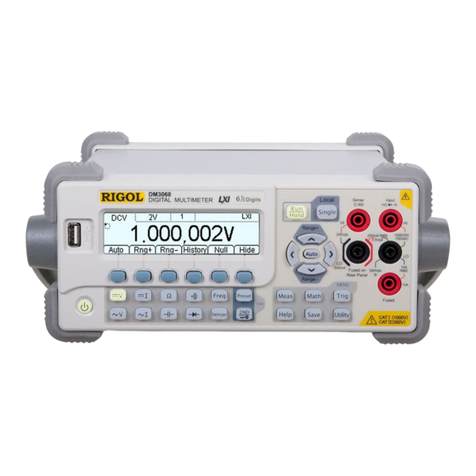
Rigol
Rigol DM3068 User manual
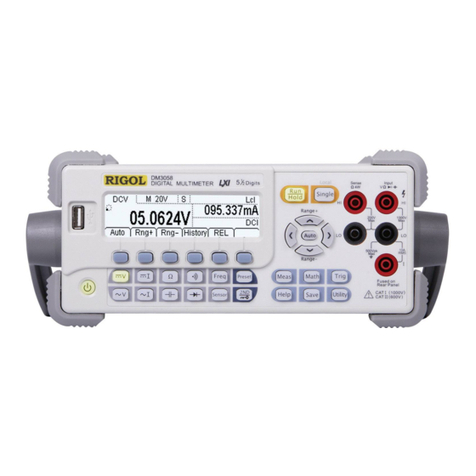
Rigol
Rigol DM3058E User manual
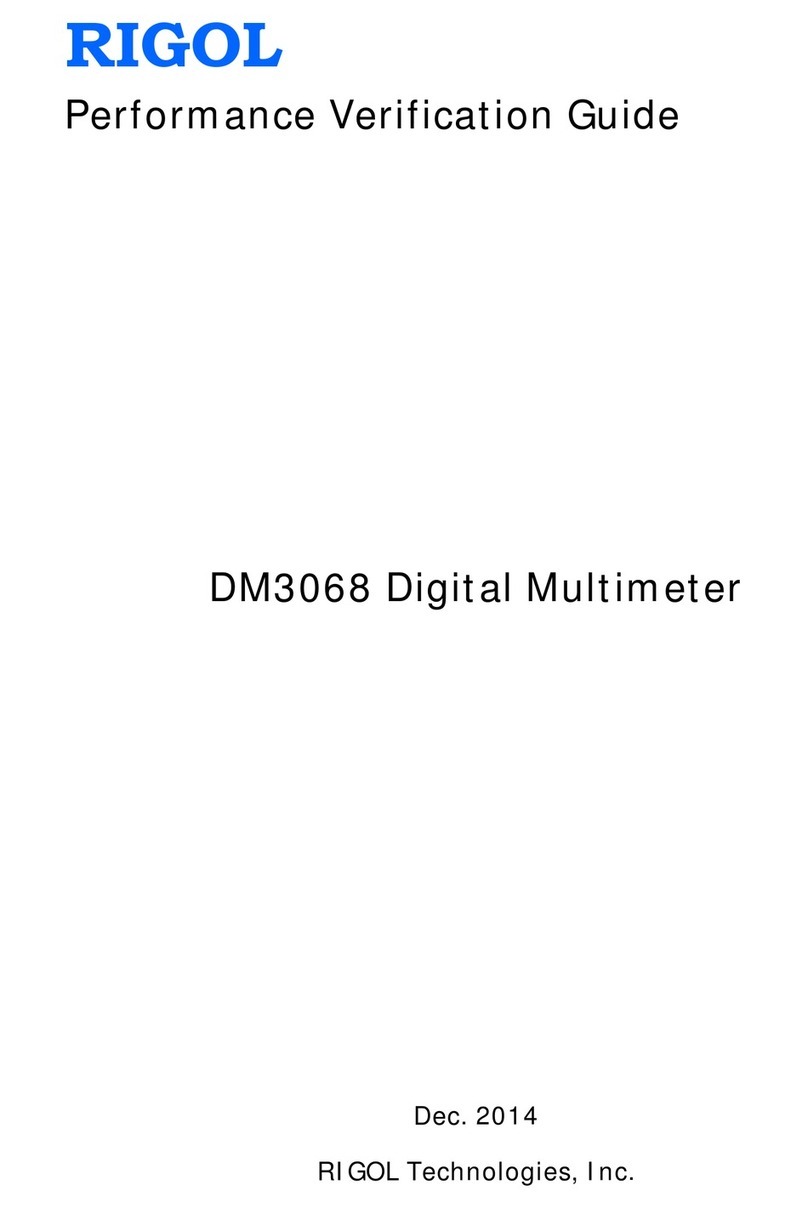
Rigol
Rigol DM3068 Installation and operation manual
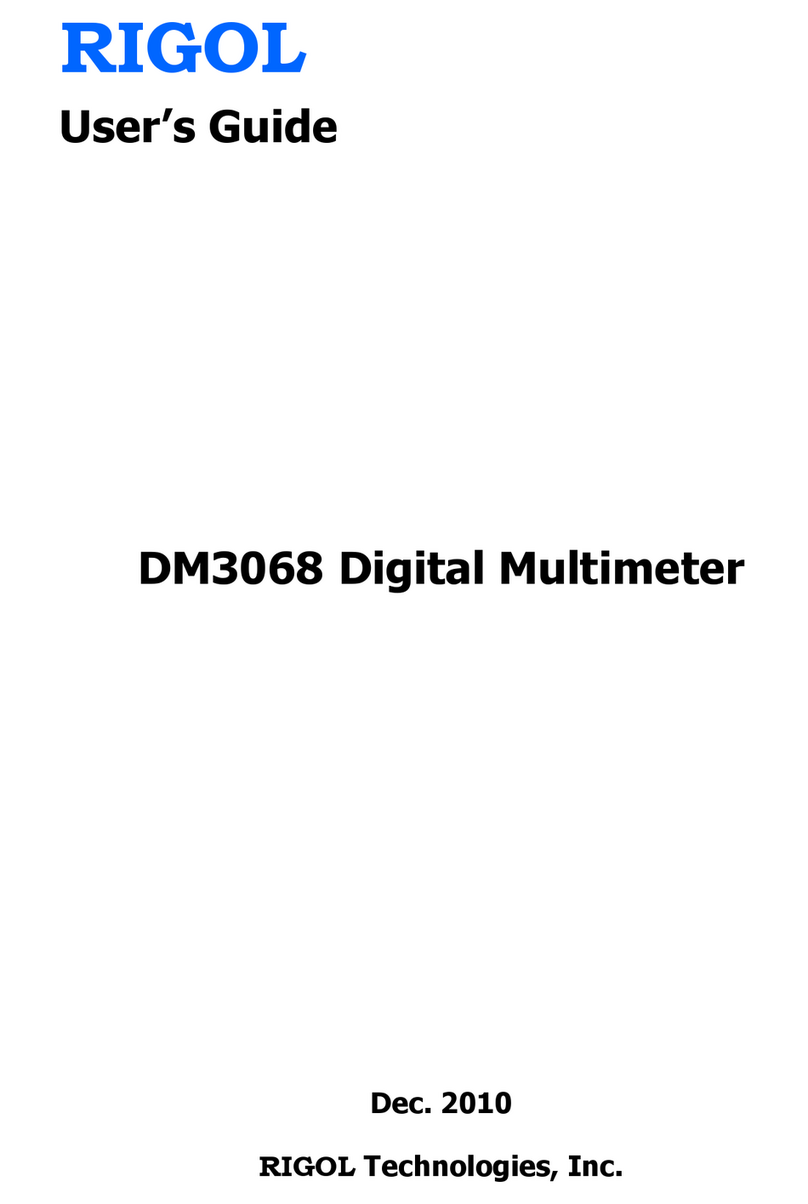
Rigol
Rigol DM3068-OB User manual
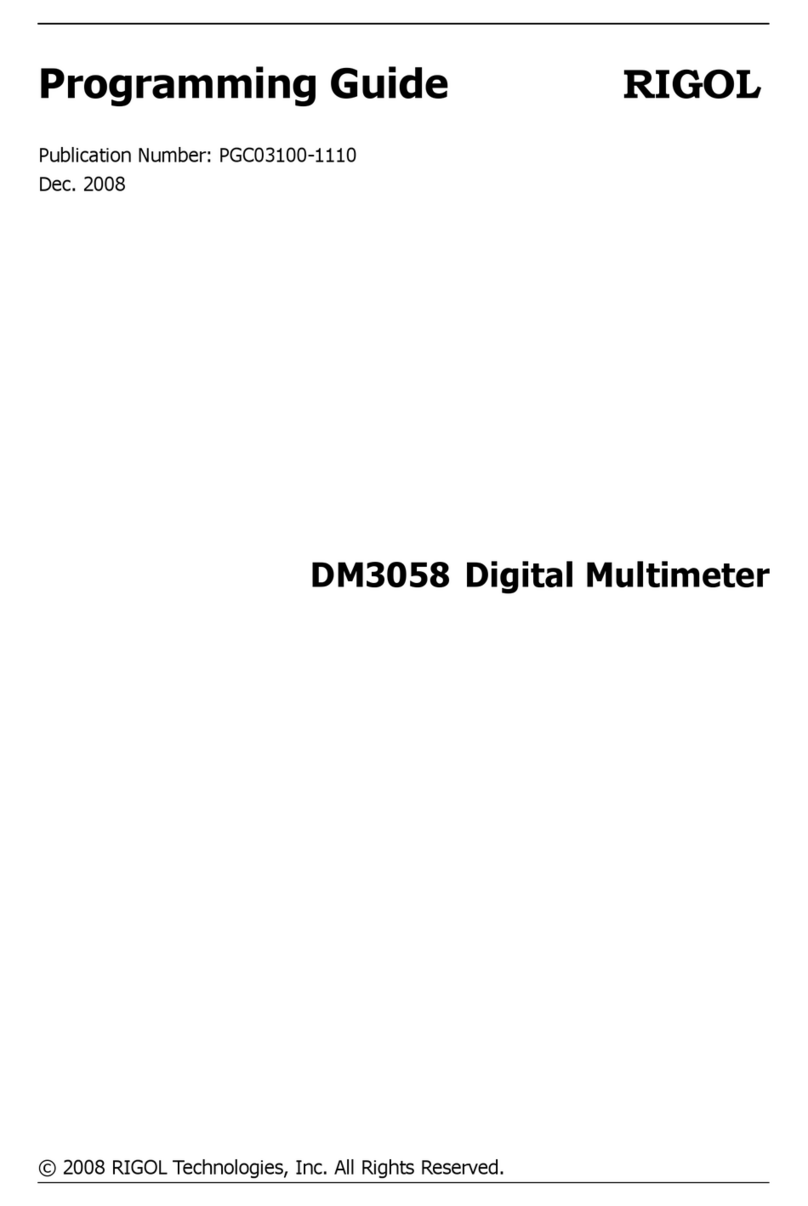
Rigol
Rigol DM3058 Operating instructions
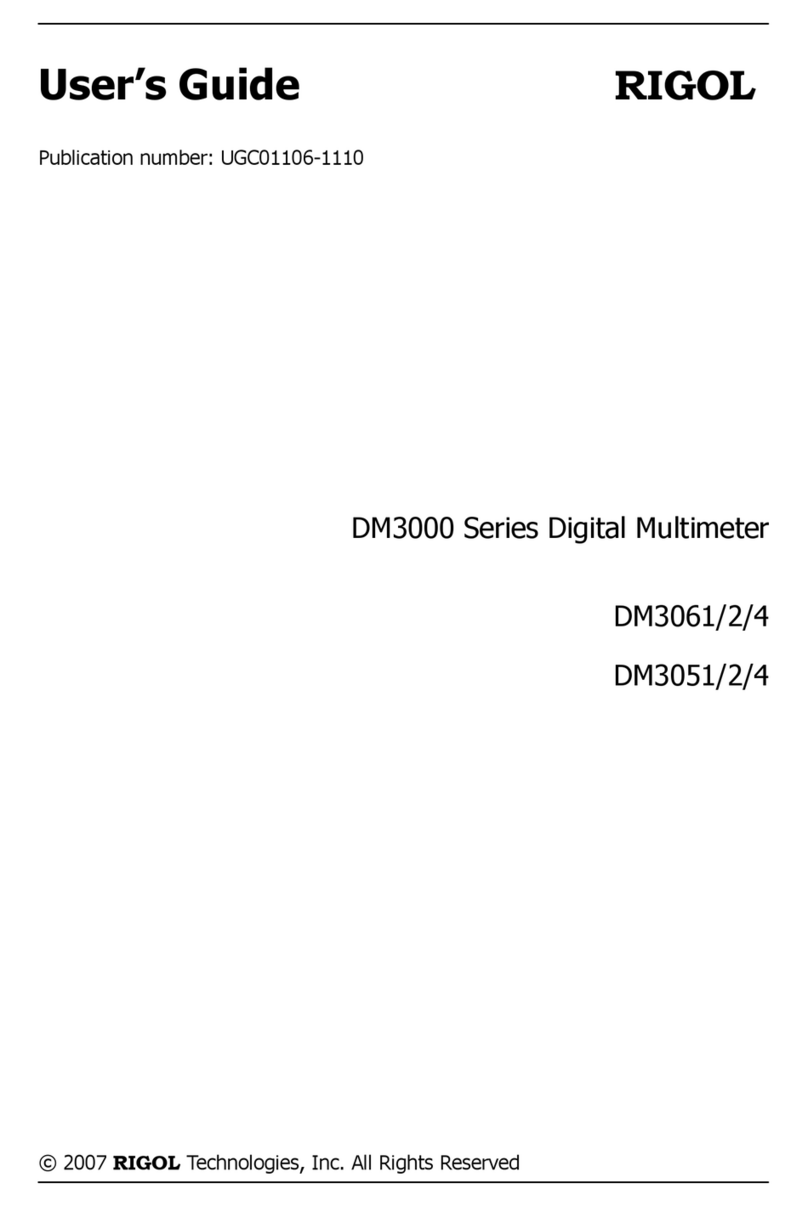
Rigol
Rigol DM3061 User manual

Rigol
Rigol DM3068 User manual
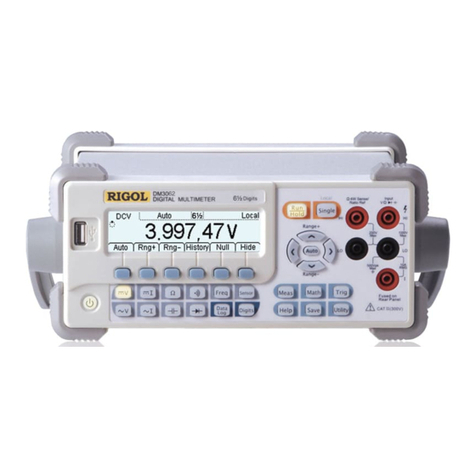
Rigol
Rigol DM3061 User manual
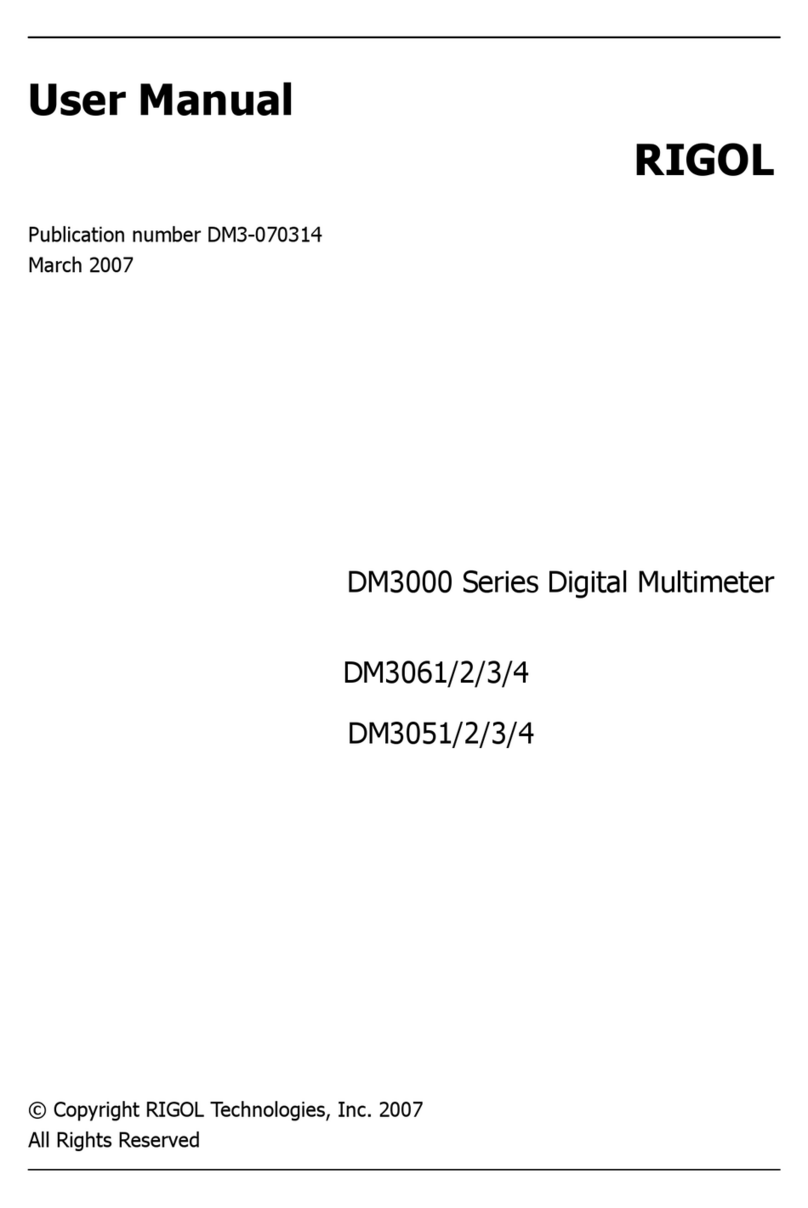
Rigol
Rigol DM3063 User manual
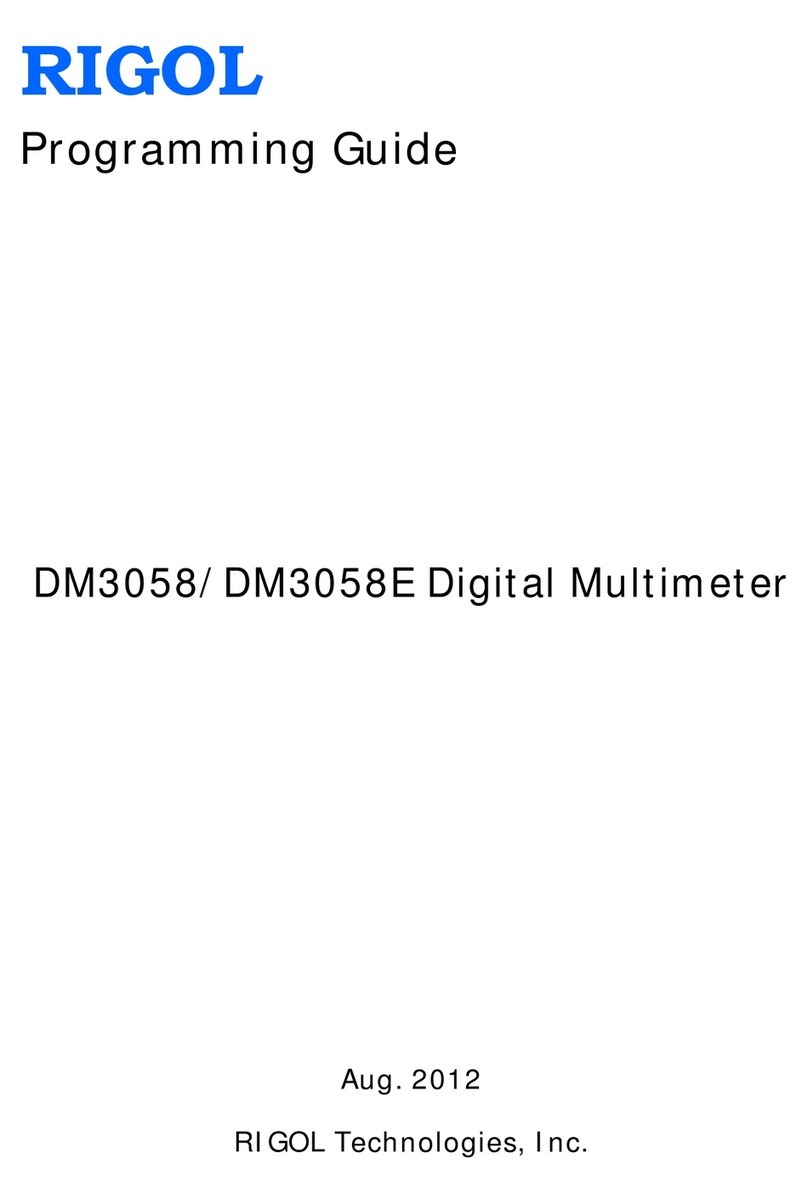
Rigol
Rigol DM3058 Operating instructions




